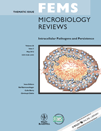Journal list menu
Export Citations
Download PDFs
Editorial
Review Articles
Mycobacterium tuberculosis: success through dormancy
- Pages: 514-532
- First Published: 09 February 2012
The shift from a state of metabolic and replicative activity to a state of dormancy as vital part of the survival stratagem of Mtb in the host is increasingly appreciated.
Internal affairs: investigating the Brucella intracellular lifestyle
- Pages: 533-562
- First Published: 28 February 2012
Recent advances in the understanding of the Brucella intracellular trafficking and bacterial factors required for a successful intracellular lifestyle
Persistence of Bartonella spp. stealth pathogens: from subclinical infections to vasoproliferative tumor formation
- Pages: 563-599
- First Published: 09 January 2012
This review will outline the current molecular knowledge how members of the arthropod-borne genus Bartonella spp. efficiently persist in their mammalian hosts to cause the typical chronic and relapsing bacteremia, which in some immunosuppressive conditions such as in AIDS is manifested by the growth of tumor-like vascular deformations.
Salmonella's long-term relationship with its host
- Pages: 600-615
- First Published: 15 February 2012
This review discusses current knowledge about mechanisms Salmonella uses to persist systemically for long period of time in its host.
Host–pathogen checkpoints and population bottlenecks in persistent and intracellular uropathogenic Escherichia coli bladder infection
- Pages: 616-648
- First Published: 09 March 2012
Urinary tract infections are an increasingly troublesome public health concern due to rapidly rising antibiotic resistance among uropathogenic bacteria worldwide. Here we highlight recent studies of intracellular and persistent uropathogenic E. coli during infections of the urinary bladder, focusing on the identification of host-pathogen checkpoints and bacterial population bottlenecks during acute and chronic cystitis that present opportunities for developing new therapeutic strategies.
Measles virus, immune control, and persistence
- Pages: 649-662
- First Published: 08 February 2012
Measles is an acute virus infection that is associated with prolonged virus clearance and risk of persistent infection.
Failure of innate and adaptive immune responses in controlling hepatitis C virus infection
- Pages: 663-683
- First Published: 05 December 2011
Hepatitis C virus utilizes several different mechanisms to evade innate and adaptive immune responses and has thus a unique opportunity to establish viral persistence in the majority of acutely infected patients.
The molecular basis of herpes simplex virus latency
- Pages: 684-705
- First Published: 12 December 2011
This review considers current knowledge and hypotheses relating to the mechanisms involved in the establishment, maintenance and reactivation herpes simplex virus latency.
HIV latency: experimental systems and molecular models
- Pages: 706-716
- First Published: 28 February 2012
The review focuses on documenting the experiments done in the field in studying the molecular mechanisms of HIV latency from a heterochromatic angle as well as reviewing the primary latency models reported thus far.
Mechanisms of Toxoplasma gondii persistence and latency
- Pages: 717-733
- First Published: 12 September 2011
This review describes the molecular mechanisms orchestrating the development of latent tissue cysts of the protozoan parasite Toxoplasma gondii, a process that is critical to pathogenesis and transmission.
Host cell invasion by Trypanosoma cruzi: a unique strategy that promotes persistence
- Pages: 734-747
- First Published: 17 February 2012
Persistence of the parasite Trypanosoma cruzi in its host is related to its remarkable ability to invade many different cell types, by taking advantage of the mechanism responsible for repairing membrane wounds.
T cell response and persistence of the microsporidia
- Pages: 748-760
- First Published: 29 November 2011
The T cell response to the microsporidia is reviewed and its role in immune evasion mechanisms and survival strategies of these pathogens is discussed.




